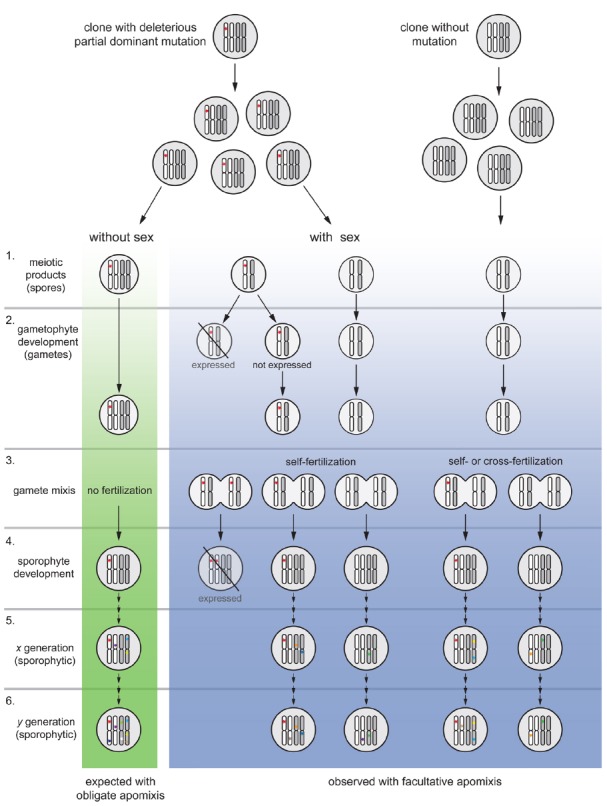FIGURE 2.

Model of purging mutations in a tetraploid, facultative apomictic plant lineage (blue column) compared to an obligate apomict (without meiosis; green column). For simplicity, the model is presented for a new self-fertile allotetraploid lineage with regularly reduced male gametes; and partial dominant mutations are considered to be deleterious and expressed a 50% penetrance. Moreover, preferred homolog pairing is assumed during meiosis I (e.g., Comai, 2005) and considers only the perspective of a mutated deleterious allele, all other alleles pondered to be functionally equivalent. The effects of absence or presence of meiosis on mutation accumulation are illustrated after one generation following the occurrence of mutation (stages 1–4), and after several generations of obligate (without sex) or facultative apomixis (with residual levels of sex; stages 5–6). 1. Once a deleterious mutation (red star) with a 50% penetrance is loaded onto the clonal offspring, without sex only unreduced female gametes rise (clonal) progeny. With sex recombinant spores are formed. 2. Expression of mutated alleles and deleterious effects would appear only in those gametophytes with a ploidy-phase change; thus, 50% of haploid gametes would be eliminated, biasing expected progeny proportions (but not progeny types). 3. During gamete mixis, parthenogenetic embryo development avoids egg-cell fertilization in apomictic female gametophytes while meiotic ones can produce an array of progeny types upon self- or cross-fertilization syndromes. 4. A dosage increase (to duplex condition) and full expression of deleterious effects is expected in some recombinant offspring during sporophyte development, but not in non-recombinant ones. Only individuals carrying a low allele dosage (simplex condition) will remain in the population together with those without the mutation. 5–6. After a number of generations, mutations will gradually appear and added up to the genetic load in the obligate apomictic lineage. In the facultative apomictic lineage, occasional sex will segregate mutated alleles and purging selection will eliminate gametophytes and sporophytes with certain allelic dosages (as in stages 1–4). On the long run, an obligate apomictic genotype (left) will become sooner extinct compared to a facultative apomictic lineage which is continuously purged. The model does not yet consider possible purging effects via conversion during meiosis, and does not quantify facultative sexuality and actual frequencies of spore formation. The model fits to higher ploidy levels if the same penetrance level is assumed in mutated alleles. Assorted colored mutations represent independent events arisen randomly in the genome at different times.
